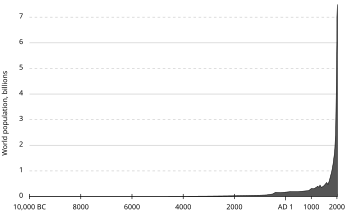 |
| (Source: The Guardian, Mann, Bradley and Hughes, 1998) |
 |
| (Source: FAQ 2.1, IPCC Fourth Assessment Report (2007), Chapter 2) |
 |
| (Source: Wikipedia, US Census Bureau) |
| (Source: Hockey Giant) |
Human civilisation has developed staggeringly rapidly since humans realised there was a lot to gain from more settled lifestyles in around 8000BC (McNeill, 1984). We shunned the nomadic hunter-gatherer lifestyle for a life of basic agriculture and settlement. We'd been shifting towards all corners of nearly all continents in some human form or another for some 200,000 years already (ibid), so why the sudden and rapid change?
We became that bit smarter. The Neolithic Revolution would have been an exciting time to be alive. It sparked the development of all the things that we take for granted but remain crucial components of our own human development today: the first planting of cereal crops (Zohary and Hopf, 2012: Domestication of Plants in the Old World), the invention of the wheel (Anthony, 2007: The horse, the wheel, and language, p67), the development of writing (ibid), mathematics (Freiberg, 1981), astronomy (Cornell, 1981: The first stargazers: an introduction to the origins of astronomy) and agriculture. These skills remain at the forefront of innovation at present.
Then we got a bit smarter. Efficiency has become the description of human endeavour. Advances in transportation (earth tracks, horses and the like) (Anthony, 2007: The horse, the wheel, and language) and farming practices (storing food between growing seasons) (Zohary and Hopf, 2012: Domestication of Plants in the Old World) meant that we could travel more quickly and grow more food. More modern economic and social class systems were born out of labour divisions (North, 1994). Cities developed. The upper class developed. Civilisation developed. Population developed. And round the story goes.
Fast forward and halt at the Industrial Revolution. Arguably human endeavour had overtaken human intelligence at this point. Another fantastic time to be alive I'm sure, but many things that must have seemed like game-changers at the time soon became symbols for the ugly side of humanity: the harnessing of efficient energy sources (Clark, 2007), the growth of global economics and labour (North, 1994), the establishment of the prosperous middle class (ibid). Or resource depletion, slavery, fragmented societies. Shortsightedness, inequality, greed.
And yet we never seemed to learn. Mistakes made by Europeans and Americans were repeated on a bigger and more spectacular scale in China with Mao's vision of the Great Leap Forward from 1958 to 1961. Up to 46 million lives were believed to have been lost in a plan to leapfrog the economic development of the USA and the UK in a space of 15 years (Dikötter, 2010: Mao’s Great Famine). The push for agricultural and industrial development cleared swathes of land for factories, settlements and infrastructure, leaving little forestry left. The mass eradication of many birds to protect crops and seeds ended up in a terrible locust swarms which resulted in famine. Unsustainable farming practices resulted in devastating soil erosion. Chinese environmental quality hasn’t yet recovered (Huntoon, 1992).
We're beginning to see a trend. Many examples of human endeavour in history have proved unsustainable. Is the development of technology and geoengineering to mitigate and manipulate climate change one of them?
The more traditional approaches to climate change fall into two categories: mitigation and adaptation. Geoengineering has forged its way to become a third category. I suppose it could be described as an adaptation of methods of mitigation. It includes a wealth of technologies that aim to deliberately modify Earth's energy balance, in turn reducing temperatures and counteracting anthropogenic climate change. Many technologies still remain in the conceptual stages and are still undergoing development (White and Mitchell, 2012: Geoengineering: Technology and Governance Assessments of Climate Engineering). Geoengineering proposals can be further split into two categories: SRM (Solar Radiation Management) and CDR (Carbon Dioxide Removal).
There have been few published studies that document the cost, environmental effects, sociopolitical impacts and legal implications of these proposals. In the following posts I will be investigating each of these aspects. Is geoengineering really the ecocentric concept that it claims to be? Is capitalism hindering or nurturing its development and application? Will it become another example on the list of unsustainable human endeavour?
This comment has been removed by the author.
ReplyDelete